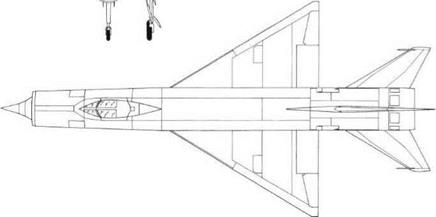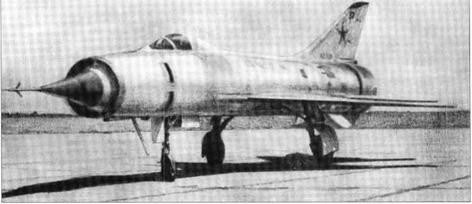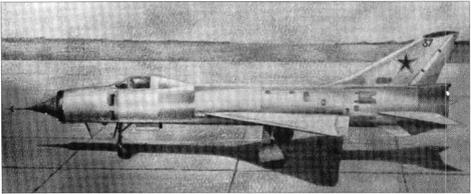Sukhoi T-37
Purpose: To meet an IA-PVO demand for a high-performance automated interception system.
Design Bureau: OKB-51 ofP O Sukhoi, Moscow.
In late 1957 the threat of USAF strategic bombers able to cruise at Mach 2 (B-58) and Mach 3 (B-70) demanded a major upgrade in the PVO defence system. At the start of 1958 a requirement was issued for manned interceptors with a speed of 3,000km/h (l,864mph) at heights up to 27km (88,583ft). Mikoyan and Sukhoi responded. Creation of the T-3A-9 interception system was authorised by the Council of Ministers on 4th June 1958. The air vehicle portion of this system was a derivative of the T-3 designated T-3A, and with the OKB-51 factory designation T-37. Detail design of this aircraft took place in the first half of 1959. In February 1960 the single flight article was approaching completion when without warning the GKAT (State Committee for Aviation Equipment) terminated the programme and ordered that the T-37 should be scrapped. The role was temporarily met by the Tu-128 and in full by the MiG-25P.
Though derived from the T-3 the T-37 was an entirely new aircraft which, because of aerodynamic guidance by CAHI (TsAGI) and the use of the same type of engine, had more in common with the MiG Ye-150. The T-3A-9 system comprised this aircraft plus the Looch (ray) ground control system, the ground and airborne radars, a Barometr-2 data link, Kremniy-2M (silicon) NPP (sight) system and two Mikoyan K-9 (R-38) missiles. The aircraft had a wing which was basically a strengthened version of the T-3 wing, with no dogtooth and with anhedral increased to 3° (ie, -3° dihedral). Each flap could be extended out on two rails to 25° and did not have an inner corner cut off at an angle. A more important change was that to avoid scraping the tail on take-off or landing the main landing gears were lengthened, which meant that the wheels were housed at an oblique angle in the bottom of the fuselage. The fuselage was totally new, with a ruling diameter of 1.7m (12ft 7in). This was dictated by the Tumanskii R-l5-300 afterburning turbojet, with dry and reheat ratings of 6,840kg (15,080 Ib) and 10,150kg (22,380 Ib) respectively. The TsP-1 radar was housed in a precisely contoured radome whose external profile formed an Os – watitsch centrebody with three cone angles to focus Shockwaves on the sharp inlet lip. The whole centrebody was translated to front and rear on rails carried by upper and lower inlet struts. Surplus air could be spilt through two powered doors in each duct outer wall at Frame 8. The pressurized cockpit had a KS-2 seat and a vee windscreen ahead of a low- drag upward-hinged canopy with a metalskinned fixed rear fairing. The detachable rear fuselage was made mainly of welded titanium, and terminated in an ejector surrounding the engine’s own variable nozzle. Initially a sliding ring, this ejector was changed to an eight-flap design during prototype manufacture. Ram air cooling inlets
were provided at Frames 25 and 29, and in the detachable rear section were four door-type airbrakes. Under this section were two radial underfins, each incorporating a steel bumper. Pivoted 140mm (51/2in) below midlevel the tailplanes had 5° anhedral and did not need anti-flutter rods as they were irreversibly driven over a range of ±2°. Each main landing gear had levered-suspension carrying a plate-braked KT-89 wheel with an 800 x 200mm tyre. The long nose gear had a power – steered lower section with a levered-suspen – sion K-283 wheel with a 570x140mm tyre, and retracted backwards. A total of 4,800 litres (1,056 Imperial gallons) of fuel could be housed in three fuselage tanks (No 3 being of bladder type) and Nos 4 and 5 between wing spars 2 and 3. Provision was made for a 930 litre (204.6Imperial gallon) drop tank. Missile pylons could be attached ahead of the ailerons. Avionics included the radar, RSIU – 5A vhf/uhf with fin-cap antennas, RSBN-2 Svod (arch) navaid and SOD-57M transponder (both with fin slot antennas), Put (course) longer-range navaid, MRP-56P marker receiver, SRZO-2 Khrom-Nikel (chrome-nickel) IFF, Lazur (azure) beam/beacon receiver of the Looch/Vozdukh (rising) ground control system, KSI compass system and a ventral blade antenna for the flight-te st telemetry.
Like the rival Mikoyan Ye-150 series (which were produced more quickly) this weapon system was overtaken by later designs.
Dimensions
Span 8.56 m 28 ft 1 in
Length overall 1 9.4 1 3 m 63ft8!iin
Wing area (gross) 34 m2 366 ft2
(net) 24.69 m2 265.8ft2
Weights
Empty 7,260kg 16,005Ib
Loaded (normal) 1 0, 750 kg 23,699 Ib
(maximum) 12 tonnes 26,455 Ib
Performance (estimated)
Max speed at 15 km (49,21 3 ft) 3,000 km/h Service ceiling 25-27 km
Range 1,500km
(with external tank) 2,000 km


![]()

 Two artist’s impressions of a T-37.
Two artist’s impressions of a T-37.










